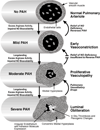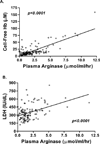Nitric oxide and arginine dysregulation: a novel pathway to pulmonary hypertension in hemolytic disorders
- PMID: 18991648
- PMCID: PMC3230043
- DOI: 10.2174/156652408786241447
Nitric oxide and arginine dysregulation: a novel pathway to pulmonary hypertension in hemolytic disorders
Abstract
Secondary pulmonary hypertension (PH) is emerging as one of the leading causes of mortality and morbidity in patients with hemolytic anemias such as sickle cell disease (SCD) and thalassemia. Impaired nitric oxide (NO) bioavailability represents the central feature of endothelial dysfunction, and is a major factor in the pathophysiology of PH. Inactivation of NO correlates with hemolytic rate and is associated with the erythrocyte release of cell-free hemoglobin, which consumes NO directly, and the simultaneous release of the arginine-metabolizing enzyme arginase, which limits bioavailability of the NO synthase substrate arginine during the process of intravascular hemolysis. Rapid consumption of NO is accelerated by oxygen radicals that exists in both SCD and thalassemia. A dysregulation of arginine metabolism contributes to endothelial dysfunction and PH in SCD, and is strongly associated with prospective patient mortality. The central mechanism responsible for this metabolic disorder is enhanced arginine turnover, occurring secondary to enhanced plasma arginase activity. This is consistent with a growing appreciation of the role of excessive arginase activity in human diseases, including asthma and pulmonary arterial hypertension. New treatments aimed at improving arginine and NO bioavailability through arginase inhibition, suppression of hemolytic rate, oral arginine supplementation, or use of NO donors represent potential therapeutic strategies for this common pulmonary complication of hemolytic disorders.
Conflict of interest statement
Authors declare no conflicts of interest.
Figures



Similar articles
-
New strategies for the treatment of pulmonary hypertension in sickle cell disease : the rationale for arginine therapy.Treat Respir Med. 2006;5(1):31-45. doi: 10.2165/00151829-200605010-00003. Treat Respir Med. 2006. PMID: 16409014
-
Dysregulated arginine metabolism, hemolysis-associated pulmonary hypertension, and mortality in sickle cell disease.JAMA. 2005 Jul 6;294(1):81-90. doi: 10.1001/jama.294.1.81. JAMA. 2005. PMID: 15998894 Free PMC article.
-
Nitric oxide metabolites and arginase I levels in β-thalassemic patients: an Egyptian study.Ann Hematol. 2012 Aug;91(8):1193-200. doi: 10.1007/s00277-012-1427-0. Epub 2012 Feb 25. Ann Hematol. 2012. PMID: 22362120
-
Mechanisms of vasculopathy in sickle cell disease and thalassemia.Hematology Am Soc Hematol Educ Program. 2008:177-85. doi: 10.1182/asheducation-2008.1.177. Hematology Am Soc Hematol Educ Program. 2008. PMID: 19074078 Review.
-
Asthma management: reinventing the wheel in sickle cell disease.Am J Hematol. 2009 Apr;84(4):234-41. doi: 10.1002/ajh.21359. Am J Hematol. 2009. PMID: 19229984 Review.
Cited by
-
Evaluation of carotid artery dynamics & correlation with cardiac & hepatic iron in β-thalassaemia patients.Indian J Med Res. 2016 Apr;143(4):443-8. doi: 10.4103/0971-5916.184302. Indian J Med Res. 2016. PMID: 27377500 Free PMC article.
-
Relationship of cell-free hemoglobin to impaired endothelial nitric oxide bioavailability and perfusion in severe falciparum malaria.J Infect Dis. 2009 Nov 15;200(10):1522-9. doi: 10.1086/644641. J Infect Dis. 2009. PMID: 19803726 Free PMC article.
-
The Effect of L-Arginine Oral Supplementation on the Improvement of Cardiovascular Function and Pulmonary Artery Pressure in Patients with Major and Intermedia β-Thalassemia.Iran J Public Health. 2023 May;52(5):1031-1037. doi: 10.18502/ijph.v52i5.12721. Iran J Public Health. 2023. PMID: 37484717 Free PMC article.
-
Red blood cell-derived arginase release in hemolytic uremic syndrome.J Transl Med. 2024 Jan 4;22(1):17. doi: 10.1186/s12967-023-04824-x. J Transl Med. 2024. PMID: 38178089 Free PMC article.
-
Structural and functional studies indicating altered redox properties of hemoglobin E: implications for production of bioactive nitric oxide.J Biol Chem. 2011 Jul 1;286(26):23452-66. doi: 10.1074/jbc.M110.183186. Epub 2011 Apr 29. J Biol Chem. 2011. PMID: 21531715 Free PMC article.
References
-
- Bunn HF. Pathogenesis and treatment of sickle cell disease. N Engl J Med. 1997;337:762–769. - PubMed
-
- Stuart MJ, Nagel RL. Sickle-cell disease. Lancet. 2004;364:1343–1360. - PubMed
-
- Hebbel RP, Osarogiagbon KD. The endothelial biology of sickle cell disease: Inflammation and a chronic vasculopathy. Microcirculation. 2004;11:129–151. - PubMed
-
- Frenette PS. Sickle cell vaso-occlusion: multistep and multicellular paradigm. Curr Opin Hematol. 2002;9:101–106. - PubMed
-
- Parise LV, Telen MJ. Erythrocyte adhesion in sickle cell disease. Curr Hematol Rep. 2003;2:102–108. - PubMed
Publication types
MeSH terms
Substances
Grants and funding
LinkOut - more resources
Full Text Sources
Medical
